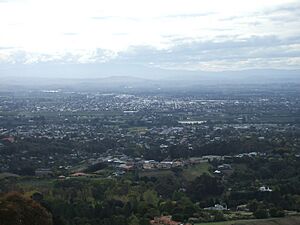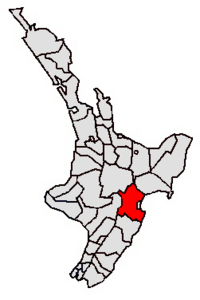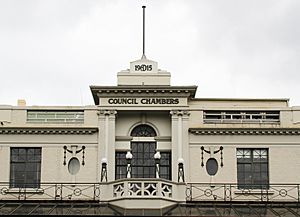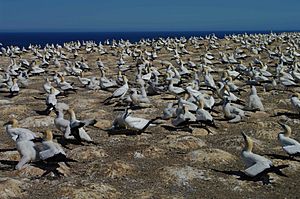Hastings District, New Zealand facts for kids
Quick facts for kids
Hastings District
|
|
|---|---|
|
Territorial authority district
|
|
 |
|
 |
|
| Country | New Zealand |
| Region | Hawke's Bay Region |
| Wards |
|
| Seat | Hastings |
| Area | |
| • Land | 5,226.71 km2 (2,018.04 sq mi) |
| Population
(June 2023)
|
|
| • Total | 91,900 |
| Time zone | UTC+12 (NZST) |
| • Summer (DST) | UTC+13 (NZDT) |
| Postcode(s) |
Map of postcodes
|
| Area code(s) | 06 |
The Hastings District is a special area in the Hawke's Bay Region of New Zealand. It's located on the east coast of the North Island. This district is like a local government area, covering the southern part of the Hawke's Bay coast. It does not include Napier City, which is a separate area.
The main office for the Hastings District Council is in the city of Hastings. This is the biggest town in the district. The Hastings District covers about 5,227 square kilometres. As of 2018, about 91,900 people live here. This makes it one of the top ten largest districts in New Zealand by population.
A big part of the population lives in the main urban areas. These include Hastings city, Havelock North, and Clive. The rest of the people live in smaller towns and rural areas. The current mayor of Hastings District is Sandra Hazlehurst. She was first elected in 2017 and then again in 2019.
Contents
Council History
Local government in the Hastings area started a long time ago. In 1871, there was a group called the Havelock North Roads Board. This group helped manage the roads. Later, in 1912, it became a Town Board, and then in 1952, it was called the Havelock North Borough Council.
Hastings itself started as a Town District in 1884. It became the Hastings Borough Council in 1886 and then the Hastings City Council in 1956. There was also the Hawke's Bay County, which was set up in 1876.
The current Hastings District was formed in 1989. This happened when the Havelock North Borough Council, Hastings City Council, and Hawke’s Bay County Council all joined together. This was part of bigger changes to local government across New Zealand.
People and Population
The Hastings District covers about 5,226.71 square kilometres. It has an estimated population of 91,900 people. This means there are about 17.6 people living in each square kilometre.
| Historical population | ||
|---|---|---|
| Year | Pop. | ±% p.a. |
| 1991 | 64,000 | — |
| 1996 | 66,300 | +0.71% |
| 2001 | 67,400 | +0.33% |
| 2006 | 70,842 | +1.00% |
| 2013 | 73,245 | +0.48% |
| 2018 | 81,537 | +2.17% |
| 2023 | 85,965 | +1.06% |
| Ethnicity | Population |
|---|---|
| New Zealand European |
60,132
|
| Māori |
24,435
|
| Pasifika |
7,320
|
| Asian |
6,513
|
| MELAA |
690
|
| Other |
1,005
|
In the 2023 New Zealand census, the Hastings District had 85,965 people. This was an increase of 4,428 people since the 2018 census. The average age of people in the district was 38.9 years.
Many different groups of people live in Hastings District. About 69.9% are New Zealand European (also called Pākehā). About 28.4% are Māori, 8.5% are Pasifika, and 7.6% are Asian. People can belong to more than one ethnic group.
Most people in the district live in urban areas. Here are some of the main urban areas and their populations:
| Urban area | Population (June 2023) |
% of region |
|---|---|---|
| Hastings | 51,500 | 56.0% |
| Havelock North | 15,200 | 16.5% |
| Clive | 2,090 | 2.3% |
| Haumoana | 1,210 | 1.5% |
Other smaller towns and settlements in the district include:
- Whirinaki
- Whakatu
- Te Awanga
- Maraekakaho
- Waimārama
Economy
The Hastings District is famous for growing lots of apples, pears, and stone fruits. These fruits are very important for the area's economy. Many of them are sent overseas from the Napier Port.
The district has also become a key area for growing grapes and making wine. Grapes are grown in the fields around Hastings and then taken to Napier for export. Napier also provides important services for the farms and rural areas of Hastings District.
Tourism and Fun Activities
The Hastings District is a great place to visit, even though many tourists focus on nearby Napier. Tourism here is often about enjoying the "lifestyle" rather than just visiting specific attractions. Most visitors are from other parts of New Zealand.
People can fly into Hawke's Bay Airport to visit the area. Tourism in Hawke's Bay is growing quickly, bringing more and more people to Hastings.
One of the biggest reasons people visit Hastings is for its wine and food. There are over 75 wineries nearby, including New Zealand's oldest winery restaurant, Vidal Estate. You can also find many local food businesses selling cheese, meats, and other treats at the Hawke's Bay Farmer's Market. This is New Zealand's oldest and largest weekly farmer's market.
Many outdoor activities are popular, like going to the beach, exploring rivers, mountain biking, hiking, and playing golf. In summer, there are big events like the Spring Racing Carnival and the Blossom Parade.
Some special attractions in Hastings include:
- Splash Planet: This is New Zealand's largest water park, full of fun slides and pools.
- Cape Kidnappers: Here you can see the world's largest mainland colony of gannets, which are amazing seabirds.
- Te Mata Peak: This is a famous hill with great views.
- Lots of nature reserves and mountain trails for exploring.
Education
Hastings, Flaxmere, and Havelock North all have secondary schools for older students. Hastings and Havelock North also have intermediate schools for middle-grade students. Some secondary schools are just for boys or just for girls, while others are for both.
There is also a special school called Te Kura Kaupapa Māori o Te Wananga Whare Tapere o Takitimu. This school teaches everything in the Māori language and is located in the Parkvale area of Hastings.
Sister Cities
Hastings has special "sister city" relationships with other cities around the world. These relationships help people from different places learn about each other's cultures.
|




